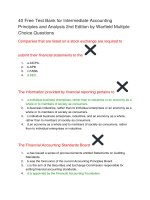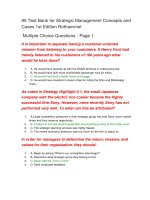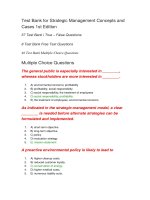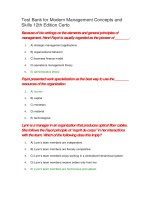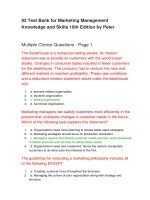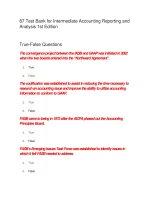Test bank for m finance applications and theory 1st edition by cornett
Bạn đang xem bản rút gọn của tài liệu. Xem và tải ngay bản đầy đủ của tài liệu tại đây (86.42 KB, 23 trang )
Full file at />
Chapter 01
Introduction to Financial Management
Multiple Choice Questions
1. Not all cash a company generates will be returned to the investors. Which of the following
will NOT reduce the amount of capital returned to the investors?
A. retained earnings
B. taxes
C. dividends
D. None of these will reduce the amount of capital returned to the investors.
2. This sub-area of finance involves methods and techniques to make appropriate decisions
about what kinds of securities to own, which firms' securities to buy, an dhow to be paid back
in the form that the investor wishes.
A. real markets
B. investments
C. financial management
D. None of these
3. This sub-area of finance looks at firm decisions in acquiring and utilizing cash received
from investors or from retained earnings.
A. investments
B. financial management
C. treasury management
D. None of these
4. Financial management involves decisions about which of the following:
A. Which projects to fund.
B. How to minimize taxation.
C. What type of capital should be raised.
D. All of these.
E. Only A and C above.
buy this full document at
Full file at />
5. This sub-area of finance helps facilitate the capital flows between investors and
companies.
A. investments
B. financial management
C. treasury management
D. financial institutions and markets
6. This sub-area of finance is important for adapting to the global economy.
A. investments
B. financial management
C. international finance
D. financial institutions and markets
7. A potential future negative impact to value and/or cash flows. This is often discussed in
terms of probability of loss and the expected magnitude of the loss.
A. options
B. standard deviation
C. coefficient of variation
D. risk
8. This is a general term for securities like stocks, bonds, and other assets that represent
ownership in a cash flow.
A. investment
B. financial asset
C. real asset
D. financial markets
9. Which of the following is the firm's highest-level financial manager?
A. Chief Executive Officer
B. Chief Financial Officer
C. Board of Directors
D. Corporate Governance
buy this full document at
Full file at />
10. Which of the following managers would NOT use finance?
A. Operational managers
B. Marketing managers
C. Human resource managers
D. All of these would use finance.
11. Which of the following personal decisions is NOT impacted by finance?
A. Borrowing money to purchase cars or homes
B. Making credit card payments
C. Making retirement decisions
D. All of these are impacted by finance.
12. When determining a form of business organization, all of the following are considered
EXCEPT:
A. Who owns the firm.
B. What are the owners' risks.
C. What are the tax ramifications.
D. The physical location of the business.
13. This is by far the most common type of business in the United States.
A. Sole proprietorship
B. Partnership
C. Corporation
D. Hybrid organizations
14. This type of business organization is relatively easy to start, and they're subject to much
lighter regulatory and paperwork burden than other business forms.
A. Sole proprietorship
B. Partnership
C. Corporation
D. Hybrid organizations
buy this full document at
Full file at />
15. This type of business organization features multiple individual owners who must report
recent profits of the business on their personal income tax returns.
A. Sole proprietorship
B. Partnership
C. Corporation
D. Hybrid organizations
16. This type of business organization is legally independent entirely from its owners.
A. Sole proprietorship
B. Partnership
C. Public Corporations
D. Hybrid organizations
17. Which of the following is NOT considered a hybrid organization?
A. S Corporation
B. Limited Liability Partnership
C. Limited Liability Company
D. Limited Partnership
E. All of these are considered hybrid organizations.
18. Which of the following exchange capital for ownership in a business?
A. Auditors
B. Agency investors
C. Angel investors
D. None of these exchange capital for ownership in a business.
19. The practice generally known as double taxation is due to
A. shareholders' dividends being taxed at both the federal and state levels.
B. corporate income being taxed at both the federal and state levels.
C. both A and B above.
D. corporate incomes being taxed at the corporate level, then again at the shareholder level
when corporate profits are paid out as dividends.
buy this full document at
Full file at />
20. As individual legal entities, corporations assume liability for their own debts, so the
shareholders hold
A. only limited liability.
B. unlimited liability.
C. shared liability.
D. joint liability.
21. For corporations, maximizing the value of owner's equity can also be stated as
A. maximizing retained earnings.
B. maximizing earnings per share.
C. maximizing net income.
D. maximizing the stock price.
22. A metaphor used to illustrate how an individual pursuing his own interests also tends to
promote the good of the community.
A. agency theory
B. angel investor
C. invisible hand
D. perks/prequisites
23. This should be the primary objective of a firm as it may actually be the most beneficial for
society in the long run.
A. Minimizing lay offs
B. Maximizing market share
C. Minimizing costs
D. Maximizing shareholder value
24. The definition of agency problem is
A. the difficulties that arise in professional baseball when players become free agents.
B. the difficulties that arise when a principle hires an agency to represent their company.
C. the difficulties that arise when a principle hires an agent and cannot fully monitor the
agent's actions.
D. when a principle hires an agent and must monitor every move they make because they
have found the agent to be unethical.
buy this full document at
Full file at />
25. Non-wage compensation which might actually enhance owner value, in that such items
may boost managers' productivity.
A. agency theory
B. angel investor
C. invisible hand
D. perks/prequisites
26. Which of these are NOT basic approaches to minimizing the agency problem?
A. Just ignore the conflict of interest.
B. Monitor managers' actions.
C. Align managers' personal interest with those of the owners by making the managers
owners.
D. All of these are basic approaches to minimizing the agency problem.
27. Which of the following is an example of aligning managers' personal interests with those
of the owners?
A. Allow the managers to have as many perks as they request.
B. Pay the managers high salaries.
C. Offer the managers an equity stake in the firm.
D. Trust the managers' actions as they will always act in the owners' best interest.
28. This is the set of laws, policies, incentives, and monitors designed to handle the issues
arising from the separation of ownership and control.
A. agency theory
B. corporate governance
C. defined benefit plan
D. invisible hand
29. This is the group who elected by stockholders to oversee management in a corporation.
A. Chief Counselors
B. Chief Executives
C. Board of Directors
D. Auditors
buy this full document at
Full file at />
30. These individuals examine the firm's accounting systems and comment on whether
financial statements fairly represent the firm's financial position.
A. accounting departments
B. Chief Financial Officers
C. Board of Directors
D. Auditors
31. These individuals follow a firm, conduct their own evaluations of the company's business
activities, and report to the investment community.
A. Auditors
B. Investment analysts
C. Investment bankers
D. Credit analysts
32. These individuals help firms access capital markets and advise managers about how to
interact with those capital markets.
A. Auditors
B. Investment analysts
C. Investment bankers
D. Credit analysts
33. These individuals examine a firm's financial strength for its debt holders.
A. Auditors
B. Investment analysts
C. Investment bankers
D. Credit analysts
34. A legal duty between two parties where one party must act in the interest of the other
party.
A. Agency theory
B. Angel Investor
C. Fiduciary
D. Investment banker
buy this full document at
Full file at />
35. Between corporate managers and stockholders, this can create ethical dilemmas.
A. Agency relationship
B. Auditors
C. Boards of Directors
D. Venture capitalist
Essay Questions
36. Explain how financial institutions and financial markets enhance the economy.
37. Explain the difference between finance and accounting.
38. Explain the competing viewpoint to Stockholder Wealth Maximization which is from the
stakeholders' perspective.
buy this full document at
Full file at />
39. One approach to aligning managers' personal interest with those of the owners is to make
the managers owners. List the avenues that a firm could use to offer managers an equity stake
in the firm.
40. How do financial institutions impact business firms?
buy this full document at
Full file at />
Chapter 01 Introduction to Financial Management Answer Key
Multiple Choice Questions
1. Not all cash a company generates will be returned to the investors. Which of the following
will NOT reduce the amount of capital returned to the investors?
A. retained earnings
B. taxes
C. dividends
D. None of these will reduce the amount of capital returned to the investors.
AACSB: Reflective Thinking
Bloom's: Remember & Understand
Difficulty: Basic
Learning Objective: 01-01 Define the subareas of finance and their roles in corporate financial management.
buy this full document at
Full file at />
2. This sub-area of finance involves methods and techniques to make appropriate decisions
about what kinds of securities to own, which firms' securities to buy, an dhow to be paid back
in the form that the investor wishes.
A. real markets
B. investments
C. financial management
D. None of these
AACSB: Reflective Thinking
Bloom's: Remember & Understand
Difficulty: Basic
Learning Objective: 01-01 Define the subareas of finance and their roles in corporate financial management.
3. This sub-area of finance looks at firm decisions in acquiring and utilizing cash received
from investors or from retained earnings.
A. investments
B. financial management
C. treasury management
D. None of these
AACSB: Reflective Thinking
Bloom's: Remember & Understand
Difficulty: Basic
Learning Objective: 01-01 Define the subareas of finance and their roles in corporate financial management.
4. Financial management involves decisions about which of the following:
A. Which projects to fund.
B. How to minimize taxation.
C. What type of capital should be raised.
D. All of these.
E. Only A and C above.
AACSB: Reflective Thinking
Bloom's: Remember & Understand
Difficulty: Basic
Learning Objective: 01-01 Define the subareas of finance and their roles in corporate financial management.
buy this full document at
Full file at />
5. This sub-area of finance helps facilitate the capital flows between investors and
companies.
A. investments
B. financial management
C. treasury management
D. financial institutions and markets
AACSB: Reflective Thinking
Bloom's: Remember & Understand
Difficulty: Basic
Learning Objective: 01-01 Define the subareas of finance and their roles in corporate financial management.
6. This sub-area of finance is important for adapting to the global economy.
A. investments
B. financial management
C. international finance
D. financial institutions and markets
AACSB: Reflective Thinking
Bloom's: Remember & Understand
Difficulty: Basic
Learning Objective: 01-01 Define the subareas of finance and their roles in corporate financial management.
7. A potential future negative impact to value and/or cash flows. This is often discussed in
terms of probability of loss and the expected magnitude of the loss.
A. options
B. standard deviation
C. coefficient of variation
D. risk
AACSB: Reflective Thinking
Bloom's: Remember & Understand
Difficulty: Basic
Learning Objective: 01-01 Define the subareas of finance and their roles in corporate financial management.
buy this full document at
Full file at />
8. This is a general term for securities like stocks, bonds, and other assets that represent
ownership in a cash flow.
A. investment
B. financial asset
C. real asset
D. financial markets
AACSB: Reflective Thinking
Bloom's: Remember & Understand
Difficulty: Basic
Learning Objective: 01-01 Define the subareas of finance and their roles in corporate financial management.
9. Which of the following is the firm's highest-level financial manager?
A. Chief Executive Officer
B. Chief Financial Officer
C. Board of Directors
D. Corporate Governance
AACSB: Reflective Thinking
Bloom's: Remember & Understand
Difficulty: Basic
Learning Objective: 01-02 Show why and how finance is at the heart of sound business decisions.
10. Which of the following managers would NOT use finance?
A. Operational managers
B. Marketing managers
C. Human resource managers
D. All of these would use finance.
AACSB: Reflective Thinking
Bloom's: Remember & Understand
Difficulty: Basic
Learning Objective: 01-02 Show why and how finance is at the heart of sound business decisions.
buy this full document at
Full file at />
11. Which of the following personal decisions is NOT impacted by finance?
A. Borrowing money to purchase cars or homes
B. Making credit card payments
C. Making retirement decisions
D. All of these are impacted by finance.
AACSB: Reflective Thinking
Bloom's: Remember & Understand
Difficulty: Basic
Learning Objective: 01-03 Apply finance in your personal life.
12. When determining a form of business organization, all of the following are considered
EXCEPT:
A. Who owns the firm.
B. What are the owners' risks.
C. What are the tax ramifications.
D. The physical location of the business.
AACSB: Reflective Thinking
Bloom's: Remember & Understand
Difficulty: Basic
Learning Objective: 01-04 Compare and contrast the advantages and disadvantages of the three most common business organizational
forms in the United States.
13. This is by far the most common type of business in the United States.
A. Sole proprietorship
B. Partnership
C. Corporation
D. Hybrid organizations
AACSB: Reflective Thinking
Bloom's: Remember & Understand
Difficulty: Basic
Learning Objective: 01-04 Compare and contrast the advantages and disadvantages of the three most common business organizational
forms in the United States.
buy this full document at
Full file at />
14. This type of business organization is relatively easy to start, and they're subject to much
lighter regulatory and paperwork burden than other business forms.
A. Sole proprietorship
B. Partnership
C. Corporation
D. Hybrid organizations
AACSB: Reflective Thinking
Bloom's: Remember & Understand
Difficulty: Basic
Learning Objective: 01-04 Compare and contrast the advantages and disadvantages of the three most common business organizational
forms in the United States.
15. This type of business organization features multiple individual owners who must report
recent profits of the business on their personal income tax returns.
A. Sole proprietorship
B. Partnership
C. Corporation
D. Hybrid organizations
AACSB: Reflective Thinking
Bloom's: Remember & Understand
Difficulty: Basic
Learning Objective: 01-04 Compare and contrast the advantages and disadvantages of the three most common business organizational
forms in the United States.
16. This type of business organization is legally independent entirely from its owners.
A. Sole proprietorship
B. Partnership
C. Public Corporations
D. Hybrid organizations
AACSB: Reflective Thinking
Bloom's: Remember & Understand
Difficulty: Basic
Learning Objective: 01-04 Compare and contrast the advantages and disadvantages of the three most common business organizational
forms in the United States.
buy this full document at
Full file at />
17. Which of the following is NOT considered a hybrid organization?
A. S Corporation
B. Limited Liability Partnership
C. Limited Liability Company
D. Limited Partnership
E. All of these are considered hybrid organizations.
AACSB: Reflective Thinking
Bloom's: Remember & Understand
Difficulty: Basic
Learning Objective: 01-04 Compare and contrast the advantages and disadvantages of the three most common business organizational
forms in the United States.
18. Which of the following exchange capital for ownership in a business?
A. Auditors
B. Agency investors
C. Angel investors
D. None of these exchange capital for ownership in a business.
AACSB: Reflective Thinking
Bloom's: Remember & Understand
Difficulty: Basic
Learning Objective: 01-04 Compare and contrast the advantages and disadvantages of the three most common business organizational
forms in the United States.
19. The practice generally known as double taxation is due to
A. shareholders' dividends being taxed at both the federal and state levels.
B. corporate income being taxed at both the federal and state levels.
C. both A and B above.
D. corporate incomes being taxed at the corporate level, then again at the shareholder level
when corporate profits are paid out as dividends.
AACSB: Reflective Thinking
Bloom's: Remember & Understand
Difficulty: Intermediate
Learning Objective: 01-04 Compare and contrast the advantages and disadvantages of the three most common business organizational
forms in the United States.
buy this full document at
Full file at />
20. As individual legal entities, corporations assume liability for their own debts, so the
shareholders hold
A. only limited liability.
B. unlimited liability.
C. shared liability.
D. joint liability.
AACSB: Reflective Thinking
Bloom's: Remember & Understand
Difficulty: Basic
Learning Objective: 01-04 Compare and contrast the advantages and disadvantages of the three most common business organizational
forms in the United States.
21. For corporations, maximizing the value of owner's equity can also be stated as
A. maximizing retained earnings.
B. maximizing earnings per share.
C. maximizing net income.
D. maximizing the stock price.
AACSB: Reflective Thinking
Bloom's: Remember & Understand
Difficulty: Intermediate
Learning Objective: 01-05 Differentiate between financial managers' appropriate and inappropriate goals.
22. A metaphor used to illustrate how an individual pursuing his own interests also tends to
promote the good of the community.
A. agency theory
B. angel investor
C. invisible hand
D. perks/prequisites
AACSB: Reflective Thinking
Bloom's: Remember & Understand
Difficulty: Intermediate
Learning Objective: 01-05 Differentiate between financial managers' appropriate and inappropriate goals.
buy this full document at
Full file at />
23. This should be the primary objective of a firm as it may actually be the most beneficial for
society in the long run.
A. Minimizing lay offs
B. Maximizing market share
C. Minimizing costs
D. Maximizing shareholder value
AACSB: Reflective Thinking
Bloom's: Remember & Understand
Difficulty: Intermediate
Learning Objective: 01-05 Differentiate between financial managers' appropriate and inappropriate goals.
24. The definition of agency problem is
A. the difficulties that arise in professional baseball when players become free agents.
B. the difficulties that arise when a principle hires an agency to represent their company.
C. the difficulties that arise when a principle hires an agent and cannot fully monitor the
agent's actions.
D. when a principle hires an agent and must monitor every move they make because they
have found the agent to be unethical.
AACSB: Reflective Thinking
Bloom's: Remember & Understand
Difficulty: Basic
Learning Objective: 01-06 Identify the firm's primary agency relationship and discuss why agency relationshps can create conflicts.
25. Non-wage compensation which might actually enhance owner value, in that such items
may boost managers' productivity.
A. agency theory
B. angel investor
C. invisible hand
D. perks/prequisites
AACSB: Reflective Thinking
Bloom's: Remember & Understand
Difficulty: Basic
Learning Objective: 01-06 Identify the firm's primary agency relationship and discuss why agency relationshps can create conflicts.
buy this full document at
Full file at />
26. Which of these are NOT basic approaches to minimizing the agency problem?
A. Just ignore the conflict of interest.
B. Monitor managers' actions.
C. Align managers' personal interest with those of the owners by making the managers
owners.
D. All of these are basic approaches to minimizing the agency problem.
AACSB: Reflective Thinking
Bloom's: Remember & Understand
Difficulty: Intermediate
Learning Objective: 01-06 Identify the firm's primary agency relationship and discuss why agency relationshps can create conflicts.
27. Which of the following is an example of aligning managers' personal interests with those
of the owners?
A. Allow the managers to have as many perks as they request.
B. Pay the managers high salaries.
C. Offer the managers an equity stake in the firm.
D. Trust the managers' actions as they will always act in the owners' best interest.
AACSB: Reflective Thinking
Bloom's: Remember & Understand
Difficulty: Intermediate
Learning Objective: 01-06 Identify the firm's primary agency relationship and discuss why agency relationshps can create conflicts.
28. This is the set of laws, policies, incentives, and monitors designed to handle the issues
arising from the separation of ownership and control.
A. agency theory
B. corporate governance
C. defined benefit plan
D. invisible hand
AACSB: Reflective Thinking
Bloom's: Remember & Understand
Difficulty: Basic
Learning Objective: 01-06 Identify the firm's primary agency relationship and discuss why agency relationshps can create conflicts.
buy this full document at
Full file at />
29. This is the group who elected by stockholders to oversee management in a corporation.
A. Chief Counselors
B. Chief Executives
C. Board of Directors
D. Auditors
AACSB: Reflective Thinking
Bloom's: Remember & Understand
Difficulty: Basic
Learning Objective: 01-06 Identify the firm's primary agency relationship and discuss why agency relationshps can create conflicts.
30. These individuals examine the firm's accounting systems and comment on whether
financial statements fairly represent the firm's financial position.
A. accounting departments
B. Chief Financial Officers
C. Board of Directors
D. Auditors
AACSB: Reflective Thinking
Bloom's: Remember & Understand
Difficulty: Basic
Learning Objective: 01-06 Identify the firm's primary agency relationship and discuss why agency relationshps can create conflicts.
31. These individuals follow a firm, conduct their own evaluations of the company's business
activities, and report to the investment community.
A. Auditors
B. Investment analysts
C. Investment bankers
D. Credit analysts
AACSB: Reflective Thinking
Bloom's: Remember & Understand
Difficulty: Intermediate
Learning Objective: 01-06 Identify the firm's primary agency relationship and discuss why agency relationshps can create conflicts.
buy this full document at
Full file at />
32. These individuals help firms access capital markets and advise managers about how to
interact with those capital markets.
A. Auditors
B. Investment analysts
C. Investment bankers
D. Credit analysts
AACSB: Reflective Thinking
Bloom's: Remember & Understand
Difficulty: Intermediate
Learning Objective: 01-06 Identify the firm's primary agency relationship and discuss why agency relationshps can create conflicts.
33. These individuals examine a firm's financial strength for its debt holders.
A. Auditors
B. Investment analysts
C. Investment bankers
D. Credit analysts
AACSB: Reflective Thinking
Bloom's: Remember & Understand
Difficulty: Intermediate
Learning Objective: 01-06 Identify the firm's primary agency relationship and discuss why agency relationshps can create conflicts.
34. A legal duty between two parties where one party must act in the interest of the other
party.
A. Agency theory
B. Angel Investor
C. Fiduciary
D. Investment banker
AACSB: Reflective Thinking
Bloom's: Remember & Understand
Difficulty: Intermediate
Learning Objective: 01-07 Incorporate ethics into financial management.
buy this full document at
Full file at />
35. Between corporate managers and stockholders, this can create ethical dilemmas.
A. Agency relationship
B. Auditors
C. Boards of Directors
D. Venture capitalist
AACSB: Reflective Thinking
Bloom's: Remember & Understand
Difficulty: Intermediate
Learning Objective: 01-07 Incorporate ethics into financial management.
Essay Questions
36. Explain how financial institutions and financial markets enhance the economy.
The real benefit of financial institutions and financial markets in enhancing the economy
occurs in how they empower people with money, but no ideas (Type 2) and people with no
money, but ideas (Type 3) by allowing them to engage in a mutually advantageous exchange,
with the Type 2 people temporarily lending their money to the Type 3 people, who put the
money into their good business ideas.
AACSB: Reflective Thinking
Bloom's: Remember & Understand
Difficulty: Intermediate
Learning Objective: 01-01 Define the subareas of finance and their roles in corporate financial management.
37. Explain the difference between finance and accounting.
In a very rough sense, the accountant's job is to keep track of what has happened to the firm's
money, while the finance job uses these historical figures with current information to
determine what to do now and in the future with the firm's money.
Accounting tends to focus and characterize the past, while finance focuses on the present and
future.
AACSB: Reflective Thinking
Bloom's: Remember & Understand
Difficulty: Basic
Learning Objective: 01-02 Show why and how finance is at the heart of sound business decisions.
buy this full document at
Full file at />
38. Explain the competing viewpoint to Stockholder Wealth Maximization which is from the
stakeholders' perspective.
The stakeholders' perspective emphasizes social responsibility over profitability. This view
maintains that managers must maximize the total satisfaction of all stakeholders in a business.
These stakeholders include the owners and shareholders, but also include the business'
customers, employees, local communities, etc.
AACSB: Reflective Thinking
Bloom's: Remember & Understand
Difficulty: Intermediate
Learning Objective: 01-05 Differentiate between financial managers' appropriate and inappropriate goals.
39. One approach to aligning managers' personal interest with those of the owners is to make
the managers owners. List the avenues that a firm could use to offer managers an equity stake
in the firm.
Corporations may take the following approaches:
a. explicitly granting shares to managers, or
b. awarding them options on the firm's stock, or
c. allowing them to purchase shares at a subsidized price though ESOPs
AACSB: Reflective Thinking
Bloom's: Remember & Understand
Difficulty: Intermediate
Learning Objective: 01-06 Identify the firm's primary agency relationship and discuss why agency relationshps can create conflicts.
40. How do financial institutions impact business firms?
Financial institutions assist business firms with transactions involving financial assets in the
financial markets. For the financial institutions to be successful at the execution of these
services, they must possess unique assets and expertise.
AACSB: Reflective Thinking
Bloom's: Apply & Analyze
Difficulty: Intermediate
Learning Objective: 01-08 Describe the complex and necessary relationships among firms: financial institutions and financial markets.
buy this full document at
